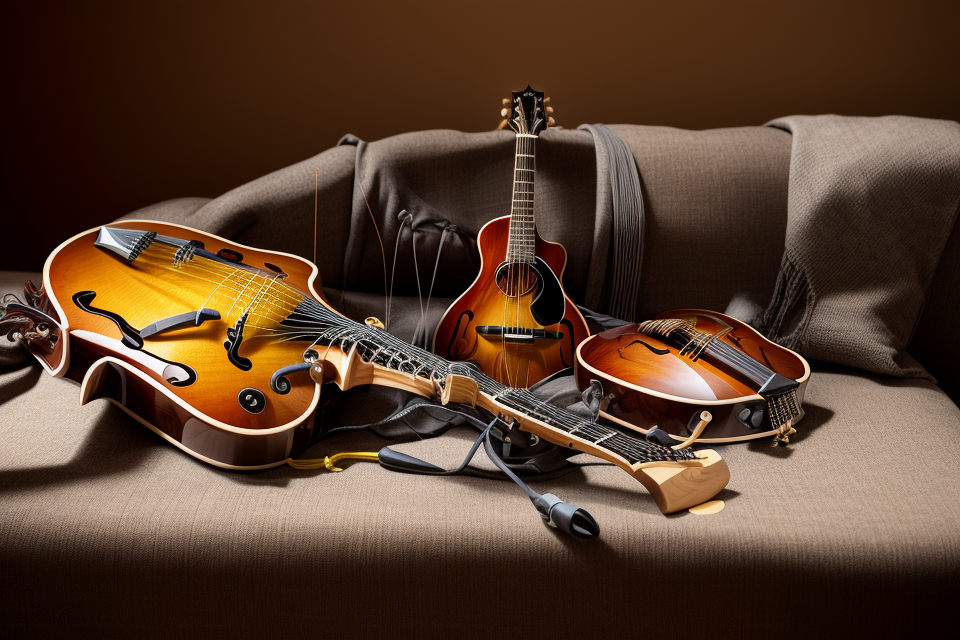Is the Mandolin really more difficult to learn than the Guitar? This question has been debated among musicians for years. Both instruments have their own unique challenges and require different skill sets. While the Guitar is often considered the more popular choice, the Mandolin has its own special place in music. With its distinctive sound and versatility, the Mandolin is an instrument that many musicians turn to for a different kind of musical experience. So, is learning to play the Mandolin more difficult than the Guitar? Let’s explore this question and find out.
Learning to play the mandolin can be more difficult than learning to play the guitar for several reasons. The mandolin has a unique tuning that is different from the guitar, which can make it harder to learn and understand. Additionally, the size and shape of the mandolin’s neck can make it more difficult to reach certain chords and notes. Finally, the technique required to play the mandolin can be different from the guitar, with a focus on fingerstyle playing rather than strumming. However, with practice and dedication, anyone can learn to play the mandolin and enjoy its unique sound and style.
Understanding the Mandolin and Guitar
What is a Mandolin?
The mandolin is a stringed instrument that belongs to the lute family. It has four strings, which are plucked or strummed with a pick or fingers to produce music. The mandolin’s body is typically made of wood, and it has a flat bottom and a curved back.
The mandolin has a history dating back to the 17th century, when it was first developed in Europe. It has since become a popular instrument in many genres of music, including bluegrass, folk, and classical music.
In terms of similarities and differences with the guitar, the mandolin has a similar tuning and playing technique. However, the mandolin has a different body shape and size, and its strings are thinner and higher off the fretboard, which can make it more challenging to play for beginners.
What is a Guitar?
Description and History
The guitar is a stringed musical instrument that originated in Spain during the 15th century. It has since become one of the most popular instruments in the world, with a wide range of styles and genres of music. The guitar typically has six strings, although 12-string guitars are also common. The instrument is played by plucking or strumming the strings with the fingers or a pick.
Similarities and Differences with the Mandolin
While both the guitar and mandolin are stringed instruments, there are some key differences between the two. One of the most obvious is the number of strings: the guitar typically has six strings, while the mandolin has four. The mandolin also has a distinctive “teardrop” shape, while the guitar is typically rectangular. In terms of playing style, the mandolin has a more percussive sound and is often used in folk and bluegrass music, while the guitar is more commonly used in rock, pop, and classical music.
Basic Anatomy of Instruments
The mandolin and guitar are two stringed instruments that are quite similar in appearance, but they have some key differences in their anatomy. These differences can impact the way the instruments are played and the difficulty of learning to play them.
Fretboard and frets
The fretboard is the part of the instrument where the strings are played, and it is usually made of wood. The frets are small metal bars that are placed at different points along the fretboard, and they are used to stop the strings at specific points. The frets on a mandolin are typically smaller and closer together than those on a guitar, which can make it more difficult to play certain chords and melodies on the mandolin.
Body size and shape
The body of the mandolin is typically smaller and more rounded than the body of a guitar. This can make the mandolin feel more comfortable to hold and play, but it can also make it more difficult to reach certain notes and chords. The body size and shape can also impact the sound of the instrument, as the smaller body of the mandolin can produce a brighter and more focused tone than a guitar.
String layout
The strings on a mandolin are laid out in a specific pattern, with the four strings closest to the fretboard being the thickest and the four strings closest to the soundhole being the thinnest. This layout can make it easier to play certain chords and melodies on the mandolin, but it can also make it more difficult to switch between chords and play certain types of music.
In summary, the basic anatomy of the mandolin and guitar can impact the difficulty of learning to play these instruments. The smaller frets and body of the mandolin can make it more difficult to play certain chords and melodies, while the specific string layout can impact the ease of switching between chords and playing certain types of music.
Learning Curve Comparison
Skill Requirements
When it comes to learning the mandolin and the guitar, the skill requirements for each instrument are different. While both instruments require knowledge of music theory, chord formation, and progressions, the mandolin presents its own unique challenges.
One of the biggest challenges when learning the mandolin is mastering the techniques and fingerings required to play it. Unlike the guitar, the mandolin has a shorter neck and a different tuning, which means that the player must learn a new set of techniques and fingerings to play it effectively.
In addition to the techniques and fingerings, the mandolin also requires a different approach to chord formation and progressions. While the guitar has a wide range of chords that can be played with different fingerings, the mandolin has a more limited range of chords that must be played in specific ways. This means that the player must learn a new set of chord progressions and techniques to play the mandolin effectively.
Another factor that makes the mandolin more difficult to learn than the guitar is the music theory involved. While both instruments require a basic understanding of music theory, the mandolin’s unique tuning and structure require a deeper understanding of music theory to play it effectively.
Overall, while the guitar and the mandolin share some similarities, the mandolin presents its own unique challenges that make it more difficult to learn than the guitar. Whether you are a beginner or an experienced musician, mastering the mandolin requires a different set of skills and knowledge than mastering the guitar.
Physical Aspects
Hand size and spacing
One of the primary physical differences between the mandolin and the guitar is the size and spacing of the strings. The mandolin has smaller strings that are spaced closer together, which can make it more challenging for beginners to press down the strings accurately and consistently. Additionally, the shorter neck of the mandolin can make it more difficult to reach certain frets, particularly for players with larger hands.
Posture and positioning
Proper posture and positioning are essential for playing both the mandolin and the guitar. However, the mandolin’s shorter neck and body can make it more challenging for players to maintain correct posture and hand positioning, particularly for those with smaller frames or less flexibility. Additionally, the mandolin’s lower strings are closer to the floor, which can make it more difficult to maintain proper finger placement and pressure while playing.
Picking and strumming techniques
The picking and strumming techniques used on the mandolin and the guitar are similar, but the mandolin’s smaller strings and closer spacing can make it more challenging to produce a clear, consistent tone. Additionally, the mandolin’s shorter scale length can make it more difficult to bend notes or achieve certain sound effects, which are more easily achieved on the guitar. However, the mandolin’s shorter neck can make it easier to reach the higher frets and play faster, more complex melodies.
Overall, while the physical aspects of playing the mandolin can present some challenges for beginners, the instrument’s unique sound and versatility make it a worthwhile investment for players looking to expand their musical horizons.
Time and Effort
When it comes to the amount of time and effort required to learn to play the mandolin compared to the guitar, there are several factors to consider.
Firstly, the physical layout of the instruments can impact the learning process. The mandolin has a more complex fretboard layout than the guitar, with four pairs of strings as opposed to the guitar’s six singles strings. This means that mandolin players must navigate more strings when shifting between chords and notes, which can make certain techniques more challenging.
Additionally, the strings on the mandolin are thinner and more responsive than those on the guitar, which can make the mandolin’s action more difficult to manage for beginners. This means that it may take more time and effort to develop the necessary hand strength and finger dexterity to play the mandolin.
Furthermore, the body size and shape of the instruments can also play a role in the learning process. The mandolin’s smaller body size and unique shape can make it more difficult to find a comfortable playing position, particularly for those with larger hands or longer fingers.
However, despite these challenges, many players find that the mandolin’s unique sound and tonal qualities make it well worth the extra effort required to master the instrument. With consistent practice and dedication, it is possible to overcome these obstacles and become a proficient mandolin player.
Adapting to Each Instrument
Finding the Right Fit
When it comes to choosing between the mandolin and the guitar, it’s important to consider not just your musical goals, but also your personal preferences and lifestyle. Here are some factors to consider when deciding which instrument is the right fit for you:
Physical and personal preferences
- Comfort: One of the most important factors to consider is how comfortable the instrument feels in your hands. Both the mandolin and the guitar have different body shapes and sizes, so it’s important to find one that fits your hand size and playing style.
- Sound: Another important factor is the sound of the instrument. Some people prefer the bright, twangy sound of the mandolin, while others prefer the warmer, richer sound of the guitar. It’s important to listen to both instruments and decide which one sounds best to your ears.
Music style and genre
- Genre: The style of music you want to play can also play a role in deciding which instrument to learn. For example, if you want to play bluegrass or folk music, the mandolin may be a better fit, while if you want to play rock, pop, or classical music, the guitar may be a better choice.
Size and portability
- Portability: If you’re looking for an instrument that you can easily take with you on the go, the mandolin may be a better choice. It’s smaller and lighter than the guitar, making it easier to transport and play in different settings.
- Storage: If you live in a small space or have limited storage options, the mandolin may also be a better choice because it takes up less space than the guitar.
Overall, when choosing between the mandolin and the guitar, it’s important to consider your personal preferences, musical goals, and lifestyle. By taking the time to evaluate these factors, you can make an informed decision about which instrument is the right fit for you.
Accessories and Supplies
When it comes to learning to play the mandolin or the guitar, having the right accessories and supplies can make a significant difference in the overall learning experience. Whether you are a beginner or an experienced player, having the right equipment can help you get the most out of your practice sessions and improve your playing skills.
Mandolin and Guitar Sizes and Types
One of the first things to consider when choosing accessories and supplies for either instrument is the size and type of the instrument itself. Mandolins come in various sizes, including the concert, soprano, and tenor sizes, while guitars come in acoustic and electric varieties. The size and type of the instrument will affect the type of accessories and supplies you need, so it’s important to choose the right ones for your specific instrument.
Accessories for Both Instruments
Some accessories are necessary for both the mandolin and the guitar, such as picks, strings, and tuners. When choosing these accessories, it’s important to consider the specific needs of each instrument. For example, mandolin strings are typically thinner and lighter than guitar strings, so they require different types of picks and tuners.
Tips for Choosing the Right Equipment
Choosing the right accessories and supplies for your mandolin or guitar can be overwhelming, especially for beginners. Here are some tips to help you choose the right equipment:
- Consider your playing style and the type of music you want to play. Different accessories and supplies are better suited for different styles of music.
- Don’t skimp on quality. While it may be tempting to save money by purchasing cheap accessories and supplies, it’s important to invest in quality equipment that will last and help you improve your playing skills.
- Research different brands and models before making a purchase. Reading reviews and talking to other musicians can help you make an informed decision.
- Experiment with different accessories and supplies to find what works best for you. Everyone has different preferences and playing styles, so don’t be afraid to try new things.
Seeking Professional Help
Benefits of private lessons
Private lessons are an excellent way to learn how to play the mandolin or guitar. A professional teacher can provide personalized instruction tailored to your learning style and skill level. They can also help you to develop good habits and technique from the beginning, which can prevent bad habits from forming later on. Additionally, private lessons can be a great way to get feedback on your progress and to address any difficulties you may be having with the instrument.
Online resources and tutorials
In addition to private lessons, there are many online resources and tutorials available for learning to play the mandolin or guitar. Websites like YouTube and instructional websites like JustinGuitar offer a wealth of free lessons and tutorials that can help you to learn the basics of playing the instrument. Many of these resources also offer more advanced lessons for those who are further along in their studies.
Joining music communities and groups
Joining a music community or group can also be a great way to learn how to play the mandolin or guitar. These groups can provide a supportive environment where you can learn from other musicians and get feedback on your playing. Additionally, many music communities and groups offer opportunities to perform and play with other musicians, which can help you to develop your skills and build confidence in your playing.
FAQs
1. What is the difference between a mandolin and a guitar?
The mandolin is a stringed instrument that has four strings, while the guitar has six strings. The mandolin has a distinctive body shape, with a teardrop-shaped body and a curved neck, while the guitar has a more rectangular body shape and a straight neck. The tuning of the mandolin is also different from the guitar, with the mandolin typically tuned in fifths like a violin, while the guitar is tuned in fourths.
2. Is it harder to learn to play the mandolin or the guitar?
Both the mandolin and the guitar can be challenging to learn, but the difficulty level can depend on the individual player. In general, the mandolin can be more difficult to learn than the guitar because of its unique tuning and the different techniques required to play it. However, with proper instruction and practice, anyone can learn to play either instrument.
3. What skills do I need to have to play the mandolin?
To play the mandolin, you will need to have good hand-eye coordination, finger dexterity, and the ability to read music or tablature. You will also need to develop a good ear for tuning and have a basic understanding of music theory. As with any instrument, consistent practice and dedication are key to becoming proficient on the mandolin.
4. How long does it take to learn to play the mandolin?
The amount of time it takes to learn to play the mandolin can vary depending on the individual player and how much time they are able to dedicate to practicing. Some people may be able to learn the basics in a few months, while others may take longer to develop the necessary skills. As with any instrument, it’s important to be patient and consistent with your practice.
5. Can I learn to play the mandolin on my own, or do I need a teacher?
While it is possible to learn to play the mandolin on your own using resources such as books, videos, and online tutorials, having a teacher can be beneficial. A teacher can provide personalized instruction, help you develop good habits and technique, and answer any questions you may have along the way. If you’re serious about learning to play the mandolin, consider finding a qualified teacher or taking lessons at a music school.


